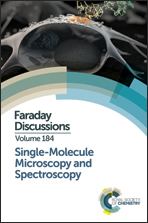Intramolecular photostabilization via triplet-state quenching: design principles to make organic fluorophores “self-healing”†
Abstract
Covalent linkage of fluorophores and photostabilizers was recently revived as a strategy to make organic fluorophores “self-healing” via triplet-state quenching. Although Lüttke and co-workers pioneered this strategy already in the 1980s, the general design principles still remain elusive. In this contribution, we combine experiments and theory to understand what determines the photostabilization efficiency in dye–photostabilizer conjugates. Our results from single-molecule microscopy and molecular dynamics simulations of different Cy5-derivatives suggest that the distance and relative geometry between the fluorophore and photostabilizer are more important than the chemical nature of the photostabilizer, e.g. its redox potential, which is known to influence electron-transfer rates. We hypothesize that the efficiency of photostabilization scales directly with the contact rate of the fluorophore and photostabilizer. This study represents an important step in the understanding of the molecular mechanism of intramolecular photostabilization and can pave the way for further development of stable emitters for various applications.
- This article is part of the themed collection: Single-Molecule Microscopy and Spectroscopy

 Please wait while we load your content...
Please wait while we load your content...